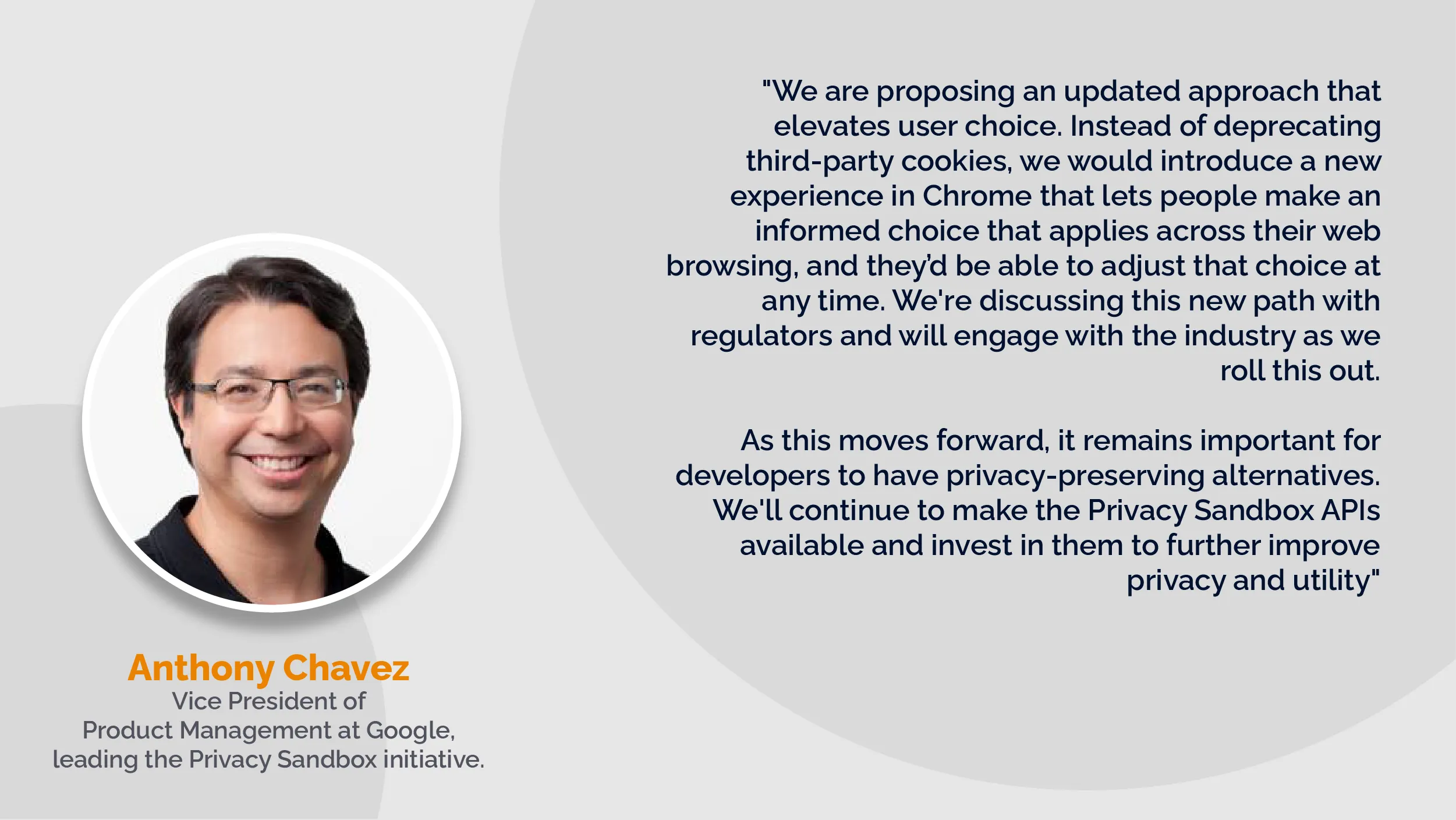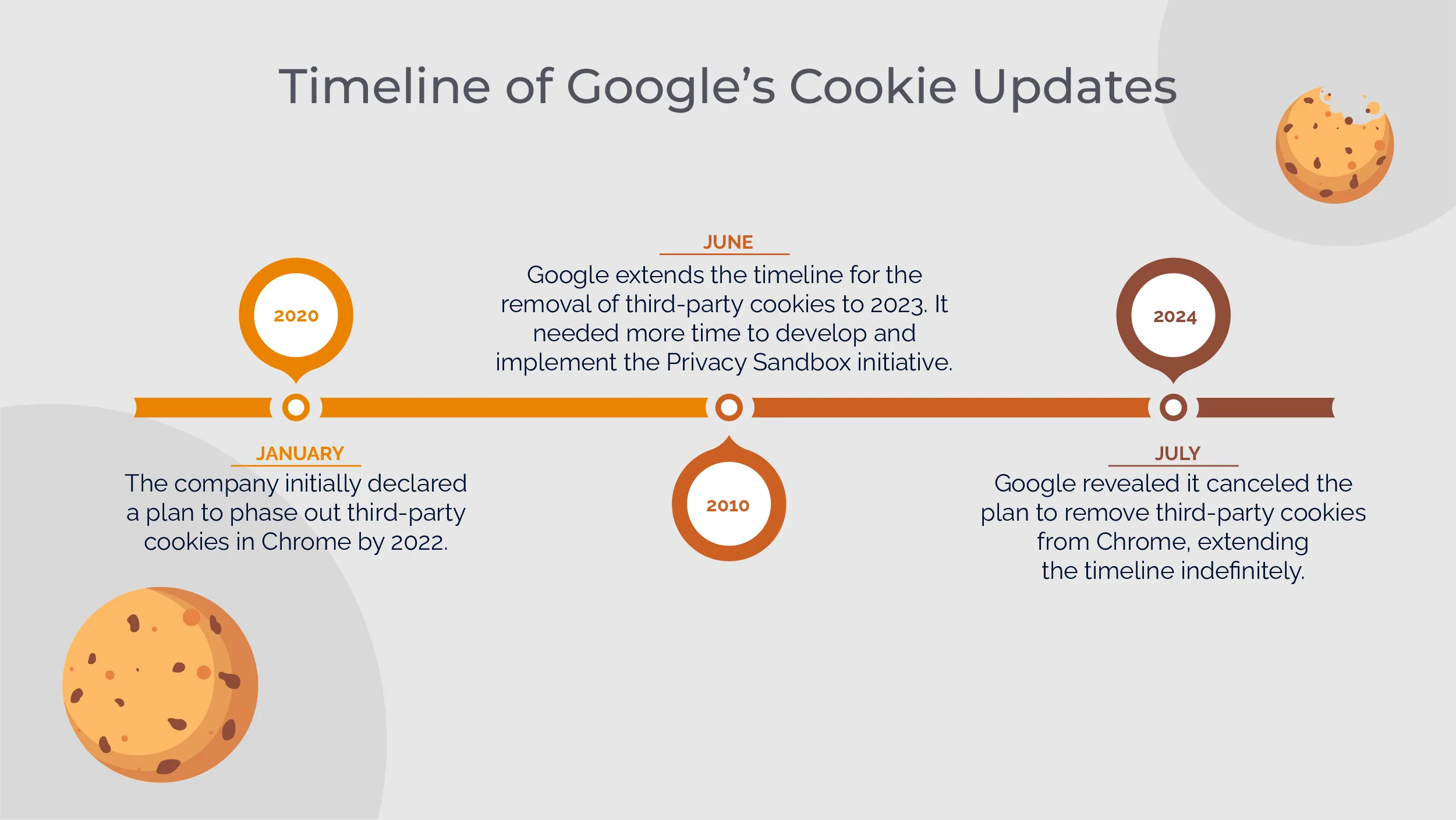Key Takeaways:
No Immediate Change: Third-party cookies on Chrome remain in use.
Privacy Sandbox Goals: Google aims to balance privacy with effective advertising.
Next Steps: Invest in first-party data, contextual ads, and privacy-preserving technologies.
Since the first announcement of Google removing third-party cookies through Google’s privacy sandbox initiative, many marketers have been concerned about its impact on tracking users’ behavior.
However, the recent Chrome third-party cookies update about the plan to cancel the removal of third-party cookies from Chrome has given a sigh of relief to various marketers. This update marks a significant paradigm shift in Google’s approach to managing online privacy and advertising. Google Chrome privacy changes will have a similar impact on digital marketers, advertisers, and web developers. Let us have a look at how the decision would impact and what the future of web tracking looks like:
What are Third-Party Cookies?
Users’ devices store small pieces of information called third-party cookies while they browse websites. Advertisers can use these cookies to improve their online advertising campaigns. Third-party cookies allow advertisers to track user behavior across multiple sites. Marketers can utilize this data to deliver tailor-made ads and measure ad performance.
Digital marketers relied on these cookies for a long time. However, increasing privacy concerns have led to an increase in the number of questions, which resulted in rising regulatory pressure to improve Google’s privacy policies.
Timeline of Google’s Cookie Updates
● January 2020
The company initially declared a plan to phase out third-party cookies in Chrome by 2022.
● June 2021
Google extends the timeline for the removal of third-party cookies to 2023. It needed more time to develop and implement the Privacy Sandbox initiative.
● July 2024
Google revealed it canceled the plan to remove third-party cookies from Chrome, extending the timeline indefinitely.
What is Google’s Privacy Sandbox Initiative?
Google, in order to address privacy concerns and to support the ad-funded web, the company introduced the Privacy Sandbox. The goal of this initiative is to develop and enforce new standards that improve user privacy while helping advertisers deliver relevant ads to the users.
Google’s Privacy Sandbox initiative integrated proposals such as the Federated Learning of Cohorts (FLoC). This proposal groups users into cohorts based on similar interests and reduces the need for individual tracking.
Google Chrome privacy changes faced a lot of criticism from privacy advocates and industry veterans. The company faced a backlash about the effectiveness of Privacy Sandbox in protecting user privacy. There was also criticism that it would facilitate Google’s dominance in the advertising market.
Google’s Privacy Sandbox Cancels the Removal of Third-Party Cookies

After approximately four years in the efforts to become cookieless, Google announced in July 2024 that it would cancel the planned removal of third-party cookies from Chrome. The company took the decision after receiving the feedback from advertisers and web developers.
Google puts a strong emphasis on its commitment to maintaining users’ privacy. The company will also focus on developing and refining the Privacy Sandbox initiative. The timeline for eliminating third-party cookies has been extended to ensure a seamless transition in the industry.
What is the Impact of Third-Party Cookies on Digital Marketing?
Google Chrome privacy changes regarding the cancellation of third-party cookie removal have significant implications for digital marketing. Advertisers and marketers that had made necessary changes to embrace a cookieless future can reevaluate their strategies. Below are some key points to consider:
1. Continued Reliance on Third-Party Cookies
As Google phases out the plan to eliminate third-party cookies, digital marketing teams can continue to leverage third-party cookies to track users’ behavior and target the campaigns accordingly until further updates. It will allow marketing teams to have more time to explore and implement alternative solutions.
2. Privacy Considerations
Even though the company plans to hold the removal of Google third-party cookies, privacy should be one of the top priorities of all enterprises. Organizations need to stay updated with Google privacy policies 2024 to adopt best practices that prioritize user consent and data protection.
3. Innovation Opportunities
The extended timeline will enable organizations to explore opportunities to develop more innovative privacy-preserving advertising technologies. Companies should consider investing in developing and testing new methods that strike a perfect balance between privacy and personalization.
What are the Alternatives to Third-Party Cookies?
The advertising and marketing industry is seeking opportunities to streamline the transition for their organizations. Here are a few third-party cookie alternatives that digital marketers can consider:
1. First-Party Data
Organizations have started gathering and utilizing first-party data. Enterprises gather this data directly from interactions with their own websites and customers.
2. Contextual Advertising
Advertisers can embrace this approach to deliver ads based on the content of the web page instead of user behavior. It is an effective way to enhance privacy while maintaining relevance.
3. Technologies That Protect Users’ Privacy
Business decision-makers need to integrate innovative technologies such as differential privacy, anonymization, and encryption in their MarTech stack to protect users’ data while enabling effective advertising.
Future Outlook Of Online Advertising Without Cookies
The future of web tracking and privacy still looks very hazy. Striking a perfect balance between privacy and advertising needs has led Google to phase out the plan to remove Chrome third-party cookies. As privacy regulations are constantly changing and customer expectations are shifting, the industry needs to adapt to the changes to meet the market’s demand.
Google’s commitment to the Privacy Sandbox indicates that changes are still on the horizon. Marketers should stay informed about developments, participate in industry discussions, and be prepared for future shifts in tracking and advertising practices.
“As this moves ahead, it stays critical for development teams to embrace privacy-preserving options. We will continue to make the Privacy Sandbox APIs accessible and invest in them to further enhance privacy and utility. We also plan to deliver more privacy controls, so we intend to implement IP Protection into Chrome’s Incognito mode”, Anthony Chavez, Vice President of Product Management at Google, leading the Privacy Sandbox initiative, said in a blog post.
Conclusion
Google’s plan to cancel the removal of third-party cookies from Chrome plays a significant role in the digital marketing industry. It offers more time for the advertising sector to adapt to the change. Additionally, Google’s privacy sandbox puts strong emphasis on the need for privacy-preserving innovations. As we navigate this evolving landscape, the focus must remain on striking a perfect balance of user privacy with effective advertising.



Comments are closed.